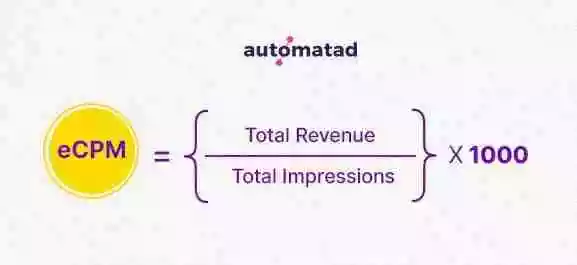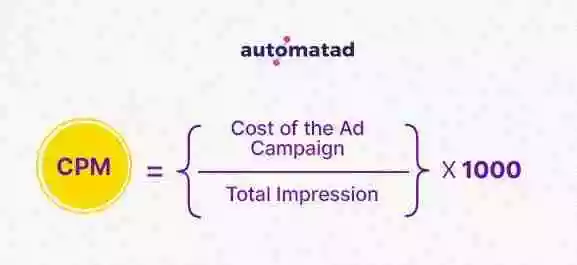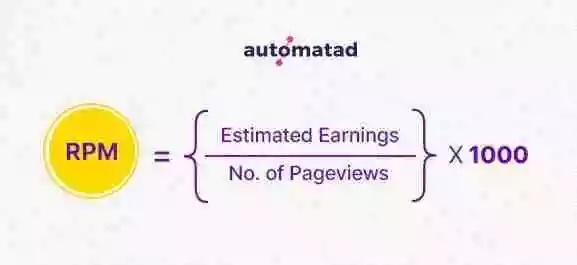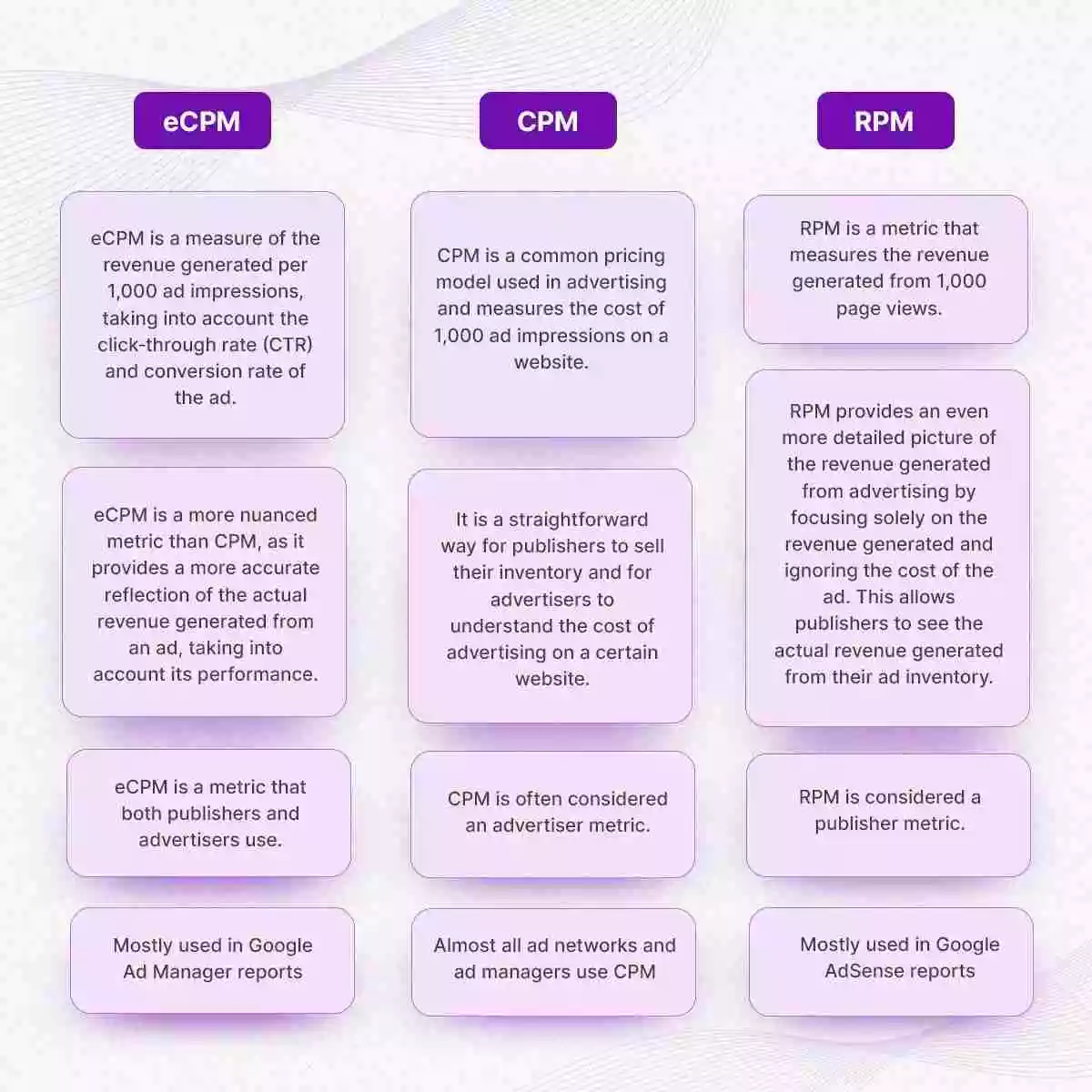The digital advertising ecosystem is full of acronyms. So obviously, you often face nail-biting moments when you see different metrics being used to measure the performance of your online advertising campaigns.
Well, fret no more as we are here to your rescue. This blog will look closely at the three most commonly used metrics: eCPM, CPM, and RPM. We will compare these metrics and explore why they are essential for publishers and when to focus on each. So, let’s begin.
Table of Contents
What Is eCPM?
eCPM stands for ‘effective cost per thousand impressions’ and is a key ad performance metric used by publishers to measure the revenue they earn from display advertising.
eCPM considers all the different campaigns running on the publisher’s inventory, including CPM (cost per mille), CPC (cost per click), and CPL (cost per lead) campaigns, making it a more informative metric for publishers to use when evaluating the performance of their ad inventory.
eCPM is calculated by dividing the total revenue generated by an ad campaign by the number of impressions the campaign received. 
Why Is eCPM Important for Publishers?
eCPM helps publishers evaluate their monetization efforts’ performance in a standardized way, regardless of the channel, ad type, or pricing model used. By calculating the revenue generated per thousand impressions, publishers can compare the effectiveness of different ad units, formats, audiences, and ad networks and make data-driven decisions about optimizing their revenue. Also, based on the average eCPM, publishers can estimate their future revenue.
Related article: What Is eCPM and 7 Proven Ways to Increase It+
What Is CPM?
CPM stands for ‘cost per thousand’ and represents the revenue publishers earn for every 1,000 ad impressions on their websites.
A publisher typically has different ad placements on their website and will set a CPM rate for each placement. Advertisers can then purchase ad space on the publisher’s website, and the publisher will earn revenue based on the number of times the ad is displayed (impressions). The publisher earns revenue regardless of whether the ad was actually viewed or created some conversions.
To calculate CPM, you would need to divide the total cost of the ad campaign by the number of impressions generated and then multiply it by 1000. 
Whereas eCPM is all about the revenue generated from the advertising campaigns irrespective of the pricing model used there, CPM is a pricing model.
Why Is CPM Important for Publishers?
Publishers love CPM as a pricing model being used by advertisers as it allows them to earn revenue based on ad impressions rather than ad performance. It is a steady revenue stream and enables the publishers to sell their best-performing ad inventories at higher CPM based on data.
CPMs can vary based on various factors such as the demand partner, geographic location, format, device, and many other criteria. This allows publishers to compare the performance of different ad units, formats, and audiences and make data-driven decisions about which ones to prioritize.
For example, suppose a publisher sees that their video ad units have a higher CPM than their display ads. In that case, they may choose to allocate more ad inventory to video ads to increase revenue. Similarly, if a publisher notices that their CPMs are higher in certain geographic locations, they may target those regions more heavily in their advertising efforts.
CPM also allows publishers to identify trends and fluctuations in the market, which can be used to negotiate better ad rates with their partners. In short, CPM helps publishers to make effective decisions to optimize the monetization of their ad inventory and maximize their revenue.
Related article: Understanding CPM: The Key Metric for Publishers’ Revenue Generation
What Is RPM?
RPM stands for ‘revenue per thousand’ and is used by the publisher to find out the revenue generated per thousand pageviews on their website.
It is calculated by dividing the estimated earnings by the number of page views and multiplying by 1,000.
RPM is generally greater than CPM since RPM calculates the cost per 1000 pageviews, including the number of ads on a page, while CPM calculates the cost per 1000 impressions of a single ad unit.
Let’s understand this with an example: Suppose a user visits a webpage with five ad units. Of these, only three ad units were placed above the fold, and the rest were below the fold. Now the user left the page halfway through the content. So now, the CPM will be calculated only for the three ad units that were under the user’s viewability range. At the same time, the RPM will be estimated by including all five ad units.
Why Is RPM Important for Publishers?
RPM is important for publishers because it helps them determine the effectiveness of their ad revenue and optimize their monetization strategy. By tracking RPM, publishers can identify high-performing ad placements, adjust pricing, and negotiate better rates with advertisers.
This metric helps publishers identify their site’s most lucrative ad placement, allowing them to put more valuable ads in more visible positions. By using RPM, publishers can ensure they are making the most of their monetization efforts and maximizing their revenue.
Related article: What Is RPM and 10 Proven Ways to Increase Your Page RPM
eCPM vs. CPM vs. RPM

Fun Fact: Both CPM and RPM are based on estimates. Thus your actual earnings can differ from those depicted using these two metrics.
Choosing the Right Ad Monetization Metric
All three metrics, CPM, eCPM, and RPM, have their own unique strengths and limitations and play important roles in helping publishers measure and understand their monetization efforts.
When deciding which metric to focus on, it ultimately depends on the specific goals and objectives of the publisher. If a publisher is looking to measure the cost of advertising, CPM would be the appropriate metric. If they are looking to compare the performance of different ad units and normalize their revenue, eCPM would be the best choice. And if they are looking to understand their overall revenue generated per thousand pageviews, RPM would be the most relevant.
Also, in addition to these metrics, publishers need to track other metrics, such as click-through rate (CTR) and conversion rate, as these can provide a complete picture of their advertising performance. By combining these metrics and using the right ones for their specific goals, publishers can make informed decisions and optimize their monetization efforts to maximize their revenue.
FAQs
Q1. How can publishers increase their eCPM, CPM, and RPM?
Publishers can increase their eCPM by creating high-quality and engaging content, targeted advertising, and using high-paying ad networks. They can increase their CPM by using native advertising, leveraging programmatic advertising, and retargeting. And they can increase their RPM by optimizing website design, using A/B testing, and diversifying ad revenue streams.
Publishers need to understand the unique requirements of each metric and tailor their approach accordingly.
Q2. What is the relationship between eCPM, CPM, and RPM?
eCPM, CPM, and RPM are all metrics used to measure ad performance, but they focus on different aspects of performance. CPM focuses on the cost of advertising, eCPM focuses on ad revenue, and RPM focuses on overall ad revenue per thousand page views.
Q3. Can eCPM, CPM, and RPM be used together to measure ad performance?
Yes, eCPM, CPM, and RPM can be used together to measure ad performance. Each metric provides different insights into ad performance, and by combining them, publishers can get a complete picture of their ad performance.























